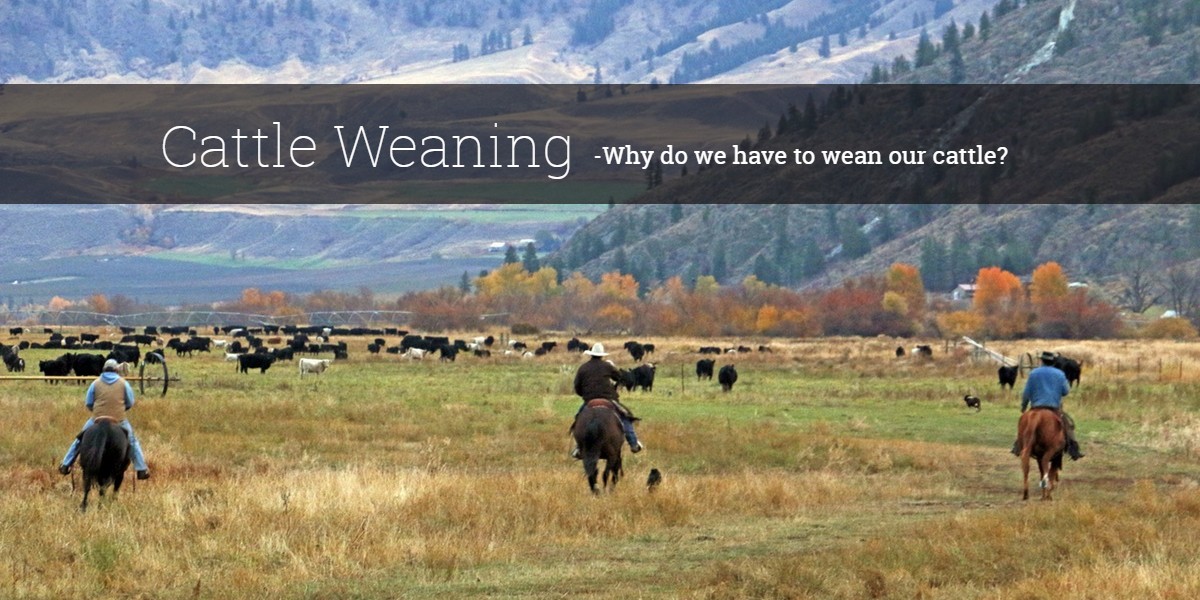Cattle Weaning -why do we have to wean our cattle?

Raising cattle responsibly means eliminating as much stress as possible from their lives, especially when the time comes to separate the calves from their mothers. This process is more commonly referred to as weaning. While the concept may sound simple, many strategies and best practices exist to eliminate as much stress as possible for the health and well-being of the cattle.
Fall works and weaning season ushers in a period of longs days and too much straight black coffee. Often we watch the sun rise and set from the back of a horse, or from the corrals where the newly weaned calves are being settled. The hard work and lack of sleep are in the best interest of our cattle.
The frost on the delicate whiskers of the horses signals the change of seasons as the ranch crew heads out to gather the cattle in the pasture out front of the ranch house. As the sun peaks over the mountains the 500 or so mother cows and calves calmly make their way to the corrals, just a short trip across the valley meadow.
The last several weeks were spent gathering the cow herd off mountain summer pastures and moving them closer to ranch headquarters. All the work is done horseback with the occasional help of a trusted cow-dog in a low-stress manner.
Once the cattle have slowly filed into our corral facilities, they are divided into smaller bunches and calves and cows are skillfully sorted from one another. A high level of horsemanship and stockmanship is displayed by the ranch crew as they efficiently, and calmly keep the calves in one pen and herd the mother cows into a neighboring pen.
At this point, the weaned calves go through individual, visual health inspections, receive a set of booster vaccinations for common cattle diseases, are dewormed and protected against lice and flies.
Afterward, the calves are placed in a pen with plenty of hay adjacent to a grass pasture that the mother cows are in. The entire process is completed in one day, (and a long day at that) many times with the cattle being put away after dark. We will repeat this process for several days until all our calves, approximately 1,400 of them, have been weaned.
Given the bond between cows and their calves they may communicate through the fence to one another for several days. After a few days, they begin to adjust and will be separated permanently.
Most calves in the Northwest are weaned in the fall time, at about 7-10 months of age and weighing anywhere from 500-700 lbs. Many factors can affect exactly when, in this time frame, cattle are weaned such as weather, or the cattle market. This is an ideal time for weaning because most calves will have -transitioned themselves to a roughage (hay and grass) based diet; only nursing on mother’s milk occasionally.
Weaning also allows the mother cows a rest period before she will give birth to her next calf in the coming spring. Appropriate and adequate rest and recovery time are key to the cow herds overall well-being and longevity.
The most important aspect of weaning is how we handle our cattle, by being as quiet and calm as possible. It helps keep the cattle calmer only having them a fence away from one another for a few days. Our head quarter’s and other corral facilities are designed for cattle to easily flow through them, minimizing stress. Additionally, cattle that are less stressed are less likely to get sick and require treatment throughout their lifetime.
We take pride in knowing we make every effort to make this process as seamless and easy on the cattle as possible.
Are there other weaning strategies?
There are a variety of ways to achieve a similar outcome. New research and technology influence changes to the process. One method- fence line weaning separates the calves and cows on the same grass diet.
Some ranches insert a small piece of plastic in the calf’s nose, which gently pokes the udder of the mother cow, not allowing the calf to nurse. With this method, they can stay together through the weaning process. This technique is becoming more popular, with approximately 5-10% of ranchers in the Northwest using it.
Ultimately, the weaning process depends on the preference of the facilities and labor available to the rancher. Everything is focused on minimizing the stress on the calf and its mother. While weaning encourages calves to mature and ready themselves for a grain-based diet, the mother cow also replenishes the energy needed to raise a calf again next year.
Tagged as: Ranching Animal Well-Being Cattle Feeding